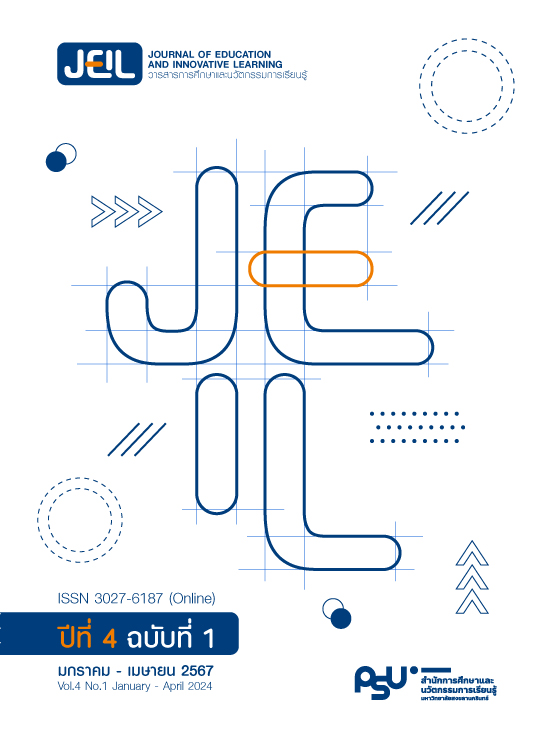ปัจจัยที่มีอิทธิพลต่อความตั้งใจในการใช้สื่อสังคมออนไลน์เพื่อการเรียนรู้ของวัยรุ่นในเขตกรุงเทพมหานคร
Main Article Content
บทคัดย่อ
งานวิจัยนี้มีวัตถุประสงค์เพื่อศึกษาระดับความตั้งใจในการใช้สื่อสังคมออนไลน์เพื่อการเรียนรู้ของวัยรุ่นในเขตกรุงเทพมหานคร และศึกษาปัจจัยที่มีอิทธิพลต่อทัศนคติและความตั้งใจในการใช้สื่อสังคมออนไลน์เพื่อการเรียนรู้ของวัยรุ่นในเขตกรุงเทพมหานคร กลุ่มตัวอย่างที่ใช้การศึกษาคือ วัยรุ่นอายุ 18-25 ปี ในกรุงเทพมหานคร จำนวน 348 คน เครื่องมือในการเก็บรวบรวมข้อมูลคือแบบสอบถาม การวิเคราะห์ข้อมูลใช้การหาค่าความถี่ ร้อยละ ค่าเฉลี่ยและส่วนเบี่ยงเบนมาตรฐานและการวิเคราะห์โมเดลสมการโครงสร้าง ผลการศึกษา พบว่า 1) ความตั้งใจใช้สื่อสังคมออนไลน์เพื่อการเรียนรู้และการใช้งานจริง พบว่า วัยรุ่นในเขตกรุงเทพมหานครมีระดับความตั้งใจในการใช้สื่อสังคมออนไลน์เพื่อการเรียนรู้อยู่ในระดับมาก (=4.04, S.D.=0.74) และระดับของการใช้สื่อสังคมออนไลน์เพื่อการเรียนรู้อยู่ในระดับมาก (
=4.05, S.D.=0.75) เช่นเดียวกัน 2) สรุปผลการทดสอบสมมติฐานโดยการวิเคราะห์โมเดลสมการโครงสร้างของปัจจัยที่มีอิทธิพลต่อความตั้งใจใช้สื่อสังคมออนไลน์เพื่อการเรียนรู้ของวัยรุ่นในเขตกรุงเทพมหานคร พบว่า โมเดลสมการโครงสร้างปัจจัยที่มีอิทธิพลต่อความตั้งใจใช้สื่อสังคมออนไลน์เพื่อการเรียนรู้ของวัยรุ่นในเขตกรุงเทพมหานครที่พัฒนาขึ้นผ่านเกณฑ์ตามค่าสถิติวัดความกลมกลืน (X2 ไม่มีนัยสำคัญทางสถิติ (p>0.05) ค่า X2/df=1.149, RMSEA=0.021, GFI=0.96, AGFI=0.92, RMR=0.02, SRMR=0.03, NFI=0.99 และ CFI=1.00) นอกจากนี้ ยังพบว่าความสมบูรณ์ของเนื้อหามีอิทธิพลต่อความพึงพอใจของผู้ใช้ ความสมบูรณ์ของเนื้อหามีอิทธิพลต่อการรับรู้ประโยชน์ การรับรู้การใช้งานง่ายมีอิทธิพลต่อทัศนคติต่อการใช้งาน การรับรู้ประโยชน์มีอิทธิพลต่อทัศนคติต่อการใช้งาน ทัศนคติต่อการใช้งานมีอิทธิพลต่อความตั้งใจใช้งาน การรับรู้ความสนุกมีอิทธิพลต่อความตั้งใจใช้งาน และความตั้งใจใช้งานมีอิทธิพลต่อการใช้งานจริง ขณะที่ความพึงพอใจของผู้ใช้งานไม่มีอิทธิพลต่อทัศนคติต่อการใช้งาน
Article Details

อนุญาตภายใต้เงื่อนไข Creative Commons Attribution-NonCommercial-NoDerivatives 4.0 International License.
เนื้อหาและข้อมูลในบทความที่ตีพิมพ์ในวารสารการศึกษาและนวัตกรรมการเรียนรู้ ถือเป็นข้อคิดเห็นและความรับผิดชอบของผู้เขียน ซึ่งกองบรรณาธิการวารสาร ไม่จำเป็นต้องเห็นด้วยหรือร่วมรับผิดชอบใด ๆ และไม่สงวนสิทธิ์การคัดลอกบทความเพื่อใช้ประโยชน์ทางวิชาการ แต่ให้อ้างอิงข้อมูลแสดงที่มาของบทความทุกครั้งที่นำไปใช้ประโยชน์
เอกสารอ้างอิง
Al-Khasawneh, M., Sharabati, A., Al-Haddad, S., Tbakhi, R., & Abusaimeh, H. (2022). The adoption of TikTok application using TAM model. International Journal of Data and Network Science, 6(4), 1389-1402. doi:10.5267/j.ijdns.2022.5.012
Al-Maroof, R., Ayoubi, K., Alhumaid, K., Aburayya, A., Alshurideh, M., Alfaisal, R., & Salloum, S. (2021). The acceptance of social media video for knowledge acquisition, sharing and application: A comparative study among YouYube users and TikTok users’ for medical purposes. International Journal of Data and Network Science, 5(3), 197-214. doi:10.5267/j.ijdns.2021.6.013
Alshurideh, M., Salloum, S. A., Al Kurdi, B., & Al-Emran, M. (2019, February 19-21). Factors affecting the social networks acceptance: an empirical study using PLS-SEM approach. In Proceedings of the 2019 8th international conference on software and computer applications (414-418). Penang Malaysia. doi:10.1145/3316615.3316720
Breslyn, W., & Green, A. E. (2022). Learning science with YouTube videos and the impacts of Covid-19. Disciplinary and Interdisciplinary Science Education Research, 4(1), 1-20. doi:10.1186/s43031-022-00051-4
Cao, G., Duan, Y., Edwards, J. S., & Dwivedi, Y. K. (2021). Understanding managers’ attitudes and behavioral intentions towards using artificial intelligence for organizational decision-making. Technovation, 106, 102312. doi:10.1016/j.technovation.2021.102312
Dumpit, D. Z., & Fernandez, C. J. (2017). Analysis of the use of social media in Higher Education Institutions (HEIs) using the Technology Acceptance Model. International Journal of Educational Technology in Higher Education, 14(1), 1-16. doi:10.1186/s41239-017-0045-2
Hair, J. F., Black, W. C., Babin, B. J., & Anderson, R. E. (2009). Multivariate data analysis: Global edition (7th ed.). New York: Pearson.
Hoi, V. N., & Hang, H. L. (2021). Understanding students’ behavioural intention to use facebook as a supplementary learning platform: A mixed methods approach. Education and Information Technologies, 26(5), 5991-6011. doi:10.1007/s10639-021-10565-5
Institute for the Promotion of Teaching Science and Technology (IPST). (2021). IPST Collaborates with TikTok to Stimulate New Era Thai Children's Learning - Digital Age Thai Teachers. Retrieved from https://www.ipst.ac.th/news/7797/tiktok01.html [in Thai]
Kahil, B., & Alobidyeen, B. (2021). Social Media Apps as a Tool for Procedural Learning During COVID-19: Analysis of Tiktok Users. Journal of Digitovation and Information System, 1(2), 25-39. doi:10.54433/JDIIS.2021100007
Kasetsart University. (2020). COVID-19 and Epidemiology. Retrieved from https://learningcovid.ku.ac.th [in Thai]
Lin, C. W., Lin, Y. S., Liao, C. C., & Chen, C. C. (2021). Utilizing technology acceptance model for influences of smartphone addiction on behavioural intention. Mathematical Problems in Engineering, 2021, 1-7. doi:10.1155/2021/5592187
Luthar, S. S., Kumar, N. L., & Zillmer, N. (2020). High-achieving schools connote risks for adolescents: Problems documented, processes implicated, and directions for interventions. American Psychologist, 75(7), 983-995. doi:10.1037/amp0000556
Mailizar, M., Burg, D., & Maulina, S. (2021). Examining university students’ behavioural intention to use e-learning during the COVID-19 pandemic: An extended TAM model. Education and Information Technologies, 26(6), 7057-7077. doi:10.1007/s10639-021-10557-5
Muninger, M. I., Hammedi, W., & Mahr, D. (2019). The value of social media for innovation: A capability perspective. Journal of Business Research, 95, 116-127. doi:10.1016/j.jbusres.2018.10.012
Qashou, A. (2021). Influencing factors in M-learning adoption in higher education. Education and Information Technologies, 26(2), 1755-1785. doi:10.1007/s10639-020-10323-z
Raza, S. A., Qazi, W., Khan, K. A., & Salam, J. (2021). Social isolation and acceptance of the learning management system (LMS) in the time of COVID-19 pandemic: an expansion of the UTAUT model. Journal of Educational Computing Research, 59(2), 183-208. doi:10.1177/0735633120960421
Salloum, S. A., Alhamad, A. Q. M., Al-Emran, M., Monem, A. A., & Shaalan, K. (2019). Exploring students’ acceptance of e-learning through the development of a comprehensive technology acceptance model. IEEE Access, 7, 128445-128462. doi:10.1109/ACCESS.2019.2939467
Soper, D. S. (2021). A-priori sample size calculator for structural equation models [Software]. Retrieved from https://www.danielsoper.com/statcalc
Sritongsuk, R., & Choeychanya. P. (2017). Factors influencing decision-making behavior to participate in event marketing of Generation Y and Generation Z in the Bangkok metropolitan area. Journal of Communication and Management NIDA, 3(1), 1-19. [in Thai]
Thongbai, N. (2020, December 18). TikTok: The Beloved Entertainment of Generation Z. In Proceedings of the 15th National and International Conference: Research and Innovation for Sustainable Development (1059-1068). Bangkok, Thailand: Sripatum University. [in Thai]
Vate-U-Lan, P. (2020). Psychological impact of e-learning on social network sites: online students’ attitudes and their satisfaction with life. Journal of Computing in Higher Education, 32(1), 27-40. doi:10.1007/s12528-019-09222-1
Wang, K., Zhu, C., & Tondeur, J. (2021). Using micro-lectures in small private online courses: what do we learn from students’ behavioural intentions?. Technology, Pedagogy and Education, 30(3), 427-441. doi:10.1080/1475939X.2020.1832565


